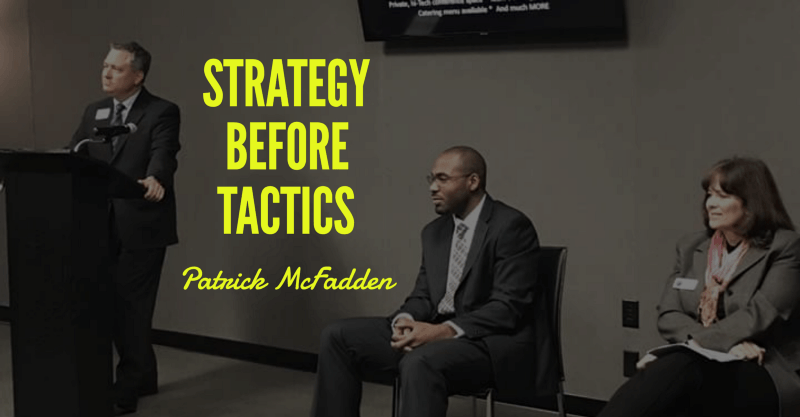Are You Asking Tactical Questions Before Strategy?
Marketing Without Strategy is the Noise Before Failure

Recently, I’ve been getting asked questions, directly and indirectly, related to the tactics a business owner or organization should use to move the needle in their business.
Here are some questions I’ve received:
- Where Else Can I Market My Services?
- What Suggestions Do You Have for Marketing to Small Business Owners?
- What Is The Best Way To Market A Salon/Spa To Set Myself Apart?
- How Do I Get Targeted Customers, Targeted Traffic to My Page and More Likes on Facebook?
- What Are Good Suggestions for Me to Get Customers Who Don’t Know They Want My Product Yet?
- How Do I Deal With Competition In My Industry?
These questions reveal a symptom of the same painful problem, which boils down to lack of a clear marketing strategy.
Even as I write these words, most business owners hear marketing strategy and immediately think websites, email newsletter, copy, LinkedIn, Facebook and promotions — you know, tactics. Heck, most well-known marketers do the same thing.
Today, I’m here to affirm that none of your tactics matter until you are crystal clear about a couple of strategy things. A marketing strategy will focus your efforts on attracting your target market and help you determine if you are going off track and what you need to do to reach your destination.
Identify your ideal customers
Don’t waste time marketing and selling to people who will never buy. Save time and energy by understanding your ideal customer in four easy questions.
Every day, 98% of the people responsible for the marketing strategy of organizations end up implementing tactics that FAIL for one simple reason: these tactics do not appeal to their ideal customer.
The secret to increasing your profitability isn’t more marketing — it’s targeting. Don’t squander your marketing budget and hundreds of hours generating leads that take your business nowhere. Find your profitable client from the outset, and everyone wins.
Think about whom your 10 best customers are and what you need to do to attract 10 more just like them!
Dive Deeper
From your client base above start looking at the characteristics of these successful accounts or best clients. You’re searching for any common characteristics that are shared by this client base.
Here’s what you are deep diving for:
- Demographics — Business2Business (B2B) demographics could be the type of industry, the job title of that individual, the years that a company has been in business, and/or revenue levels. Business2Consumer (B2C) the demographics could be age, sex, illness, income, and a particular area of town.
- Psychographics — Understand where do they hang out, what do they read, what do they listen to, what do they search online, what makes them tick, what triggers them to go looking for a solution
- Challenges or Problem — Marketing is about solving customer problems, whether those are problems customers are currently facing, or problems they will face as their marketplace evolves and their needs change.
- Real Quotes — Include a few real quotes taken during your interviews that represent your persona well. This will make it easier for employees to relate to and understand your persona.
Identify what the business is selling and what customers are really buying
This seems like a simple enough question, no trick to it really.
- If you sell insurance, you sell a piece of paper
- If you sell remodeling, you sell boards, drywall, and paint
- If you sell tax preparation, your sell a big fat envelope full of filled out forms
- If you sell automobiles, you sell four wheels, metal and a way to get around
It’s hard to argue with any of these assertions, isn’t it? I mean, that’s what you sell — but that’s not the point is it?
What you really sell is — what the buyer believes that are getting when they buy your product or service.
Stop selling what you sell and start selling what people buy.
Funny thing is — many business owners and organizations don’t even know what that is. And, it’s the most important thing there is to know. Especially if you have marketing and sales professionals.
Stop thinking in terms of what you sell and start thinking in terms of what your clients buy or think they buy. From working with various industries to help them start selling what their customers buy, here are some insights that I’ve found:
- If you sell insurance, maybe they buy a feeling of responsibility or company stability
- If you sell remodeling, maybe they buy the feeling they get when friends drop by or knowing that their family routine won’t be too screwed up
- If you sell tax preparation, maybe they buy peace of mind or a refund
- If you sell automobiles, maybe they buy that sideways glance at the stoplight or knowing their teenage daughter will make it home safe at night
Figure out what your prospects buy, not what they should buy, what they do buy and start communicating that in your marketing message to them.
Start Selling What People Buy!!!!
Look at the Competition
Looking at your competition can be incredibly motivating.
Two big pieces of news for you:
1. Competition validates you. When you own a business, the natural tendency is to worry about what your competition is doing and how much they’re charging. This is the old model of thinking; I want you to try something radically different. Instead of worrying about lowering your prices to match theirs, improve your customer service, make your place of business so welcoming and friendly people won’t want to leave.
2. You only have to do something 10% better or provide added value to be successful. Do you know your Unique Selling Proposition (USP)? How do you tell customers how you’re different from your competitors? Why should someone hire your service, product or expertise over another? Whether you are an employee, physician, dentist, pastor, teacher, web designer, author, artist, musician, human resource director, professor, politician, or entrepreneur, you must know what makes you different in a way that appeals to your ideal audience. Without that, your success will be mediocre or non-existent.
The best way to create a difference that can’t be easily copied and stand out from the competition is to:
- create your own special way to treat customers,
- create an experience that’s unique, or
- create a totally new and convenient way for people to get a result.
The difference needs to be in the way you do business, how you cultivate and build relationships, how you package your product, the way you sell your service, the way you answer the phone, your appearance on a sales call, etc. — its all in the way you provide your service or product.
Businesses that build real marketing momentum through strategy strive to do things that no one else in their market is doing or to do the same things that everyone else is doing in different ways.
- A handyman contractor creates and promotes a “Bathroom Remodeling Package” — an unheard of proposition
- An estate planning firm provides the same planning services as their competitors but packages them in fixed price bundles. — out with the bill by the minute approach
- A local printer does small batches and short runs. — wow, flexible and rapid orders
For more ways to drive better results from your marketing efforts, download our eBook: 7 Components of a Successful Marketing Plan
Have you been making these mistakes? It’s not too late to change your marketing. Let’s talk about your marketing , and how to improve it.




